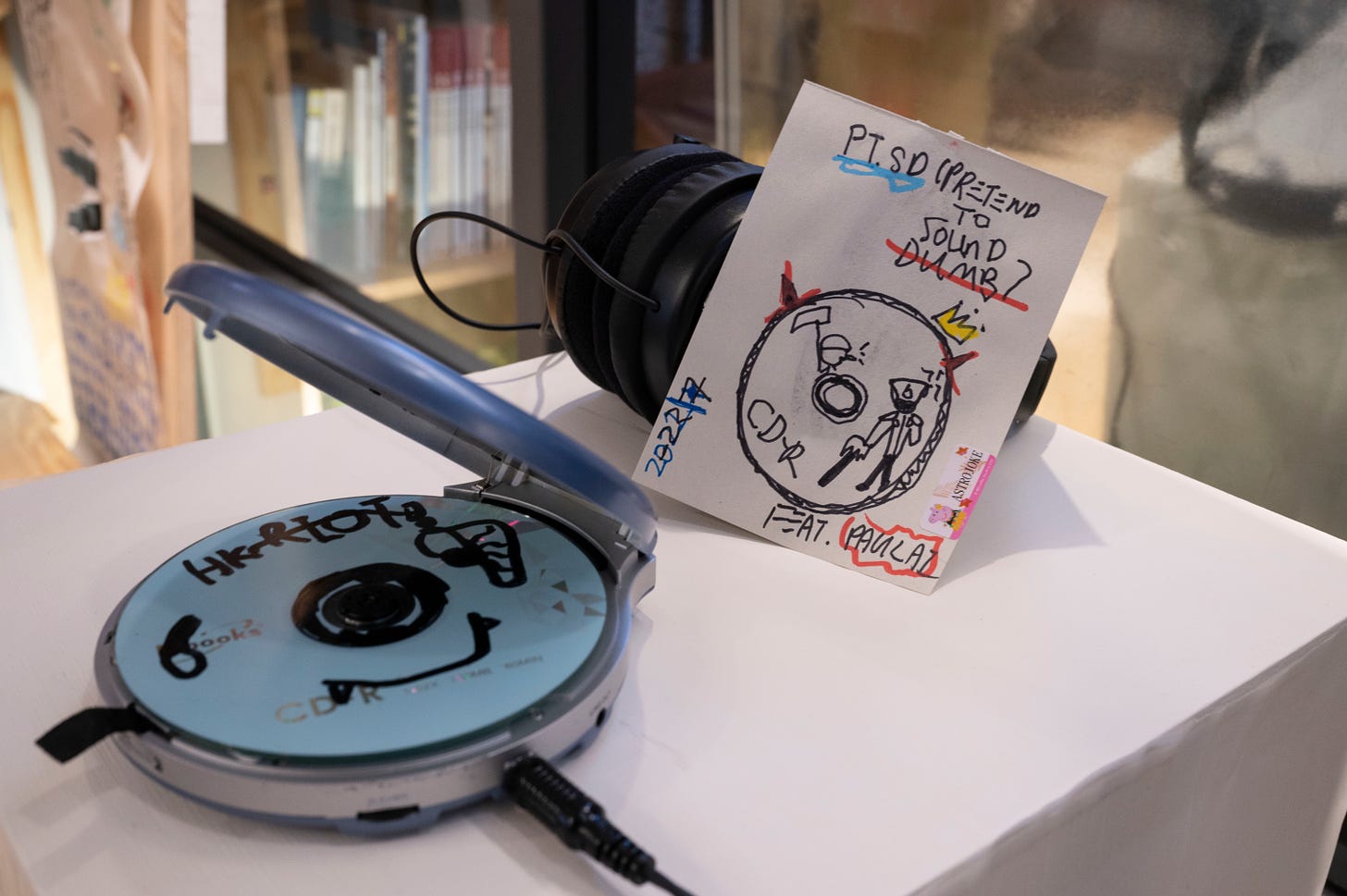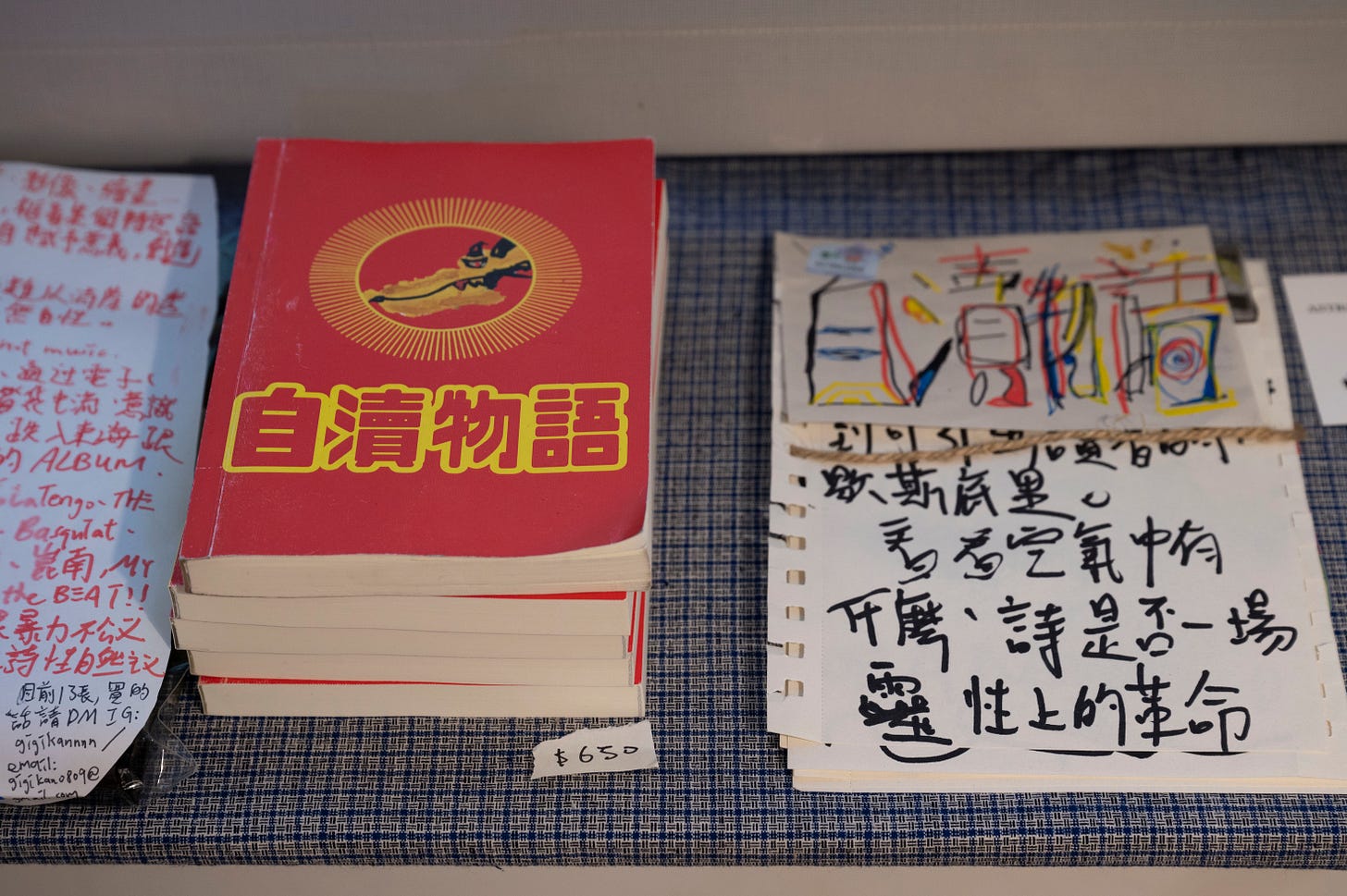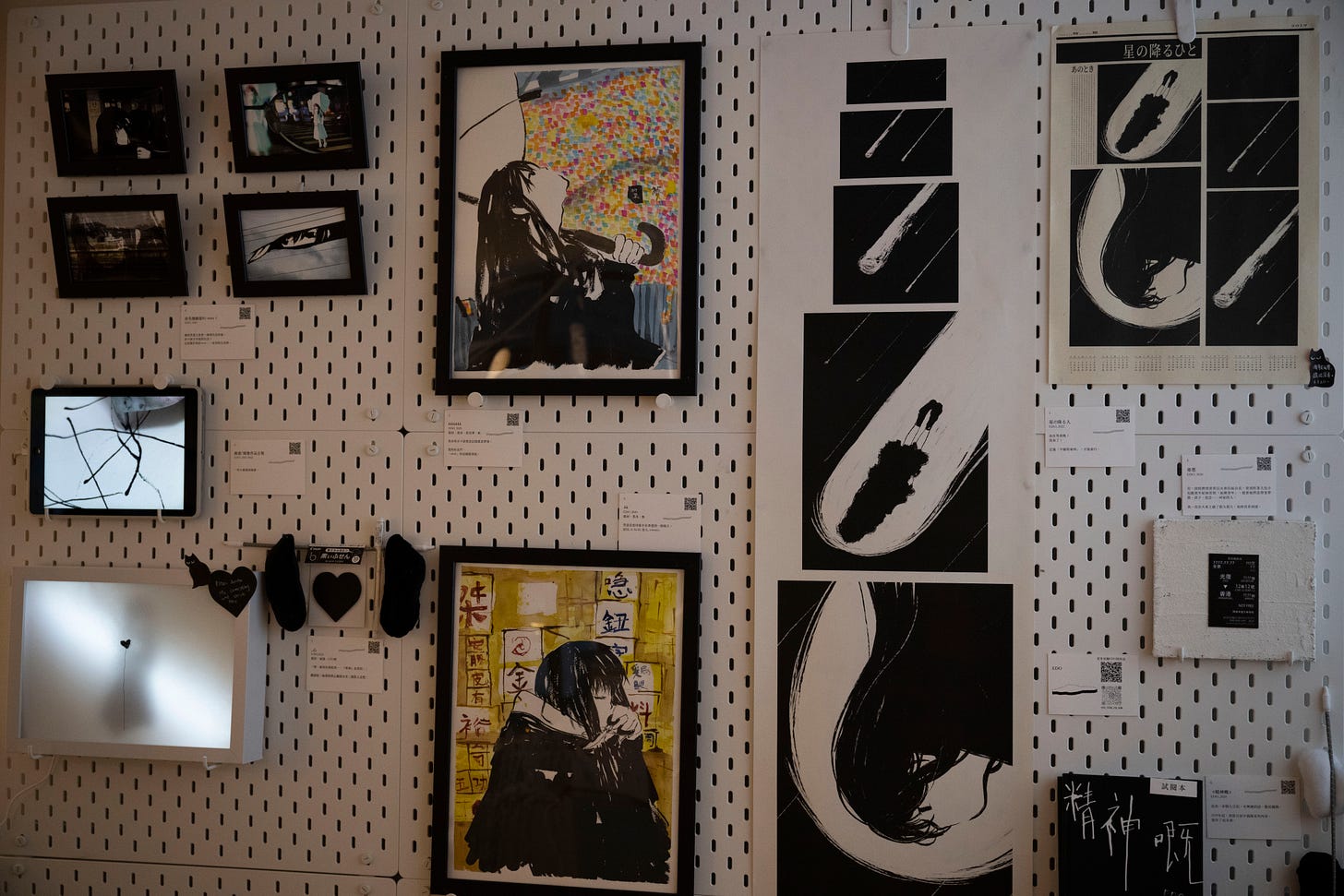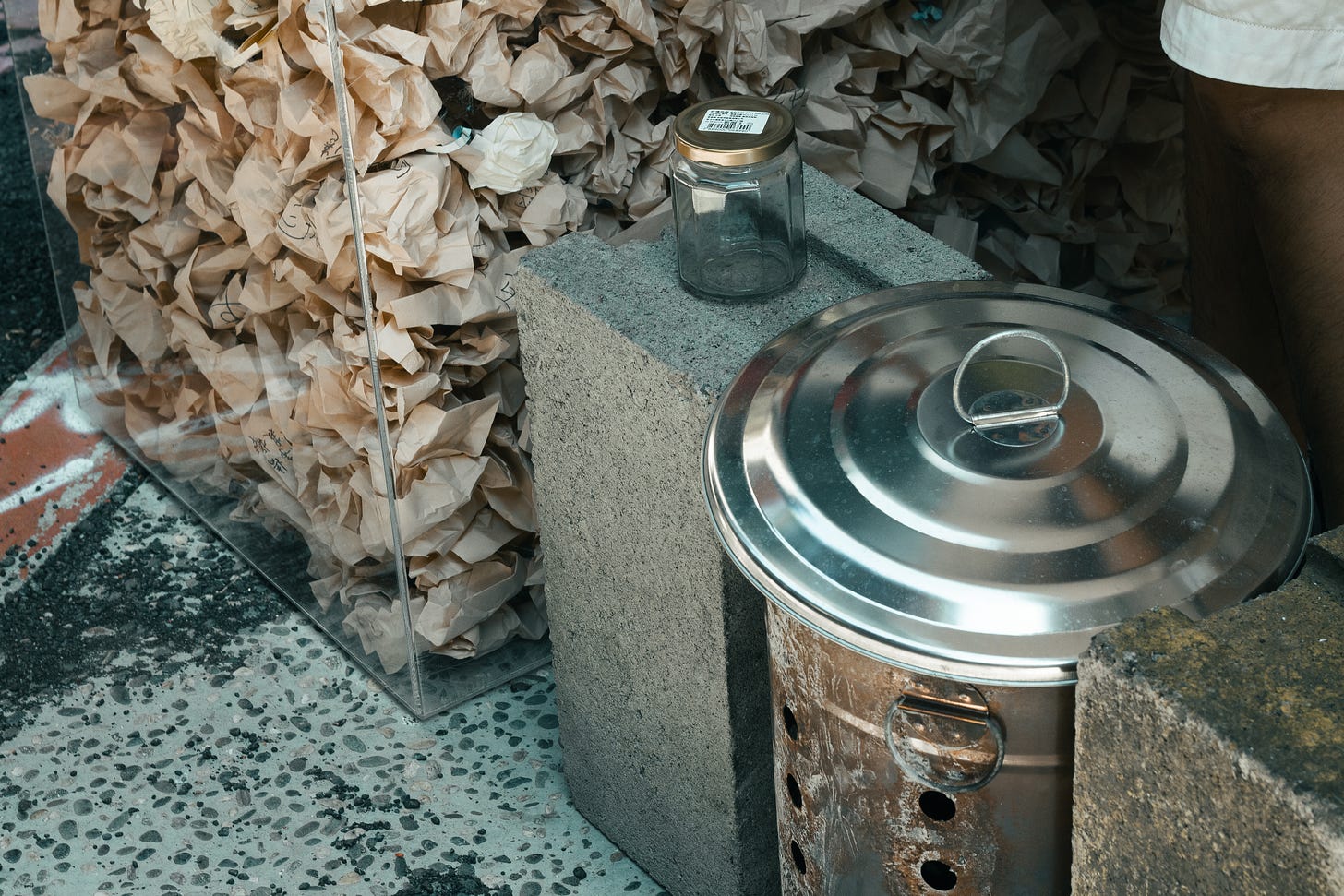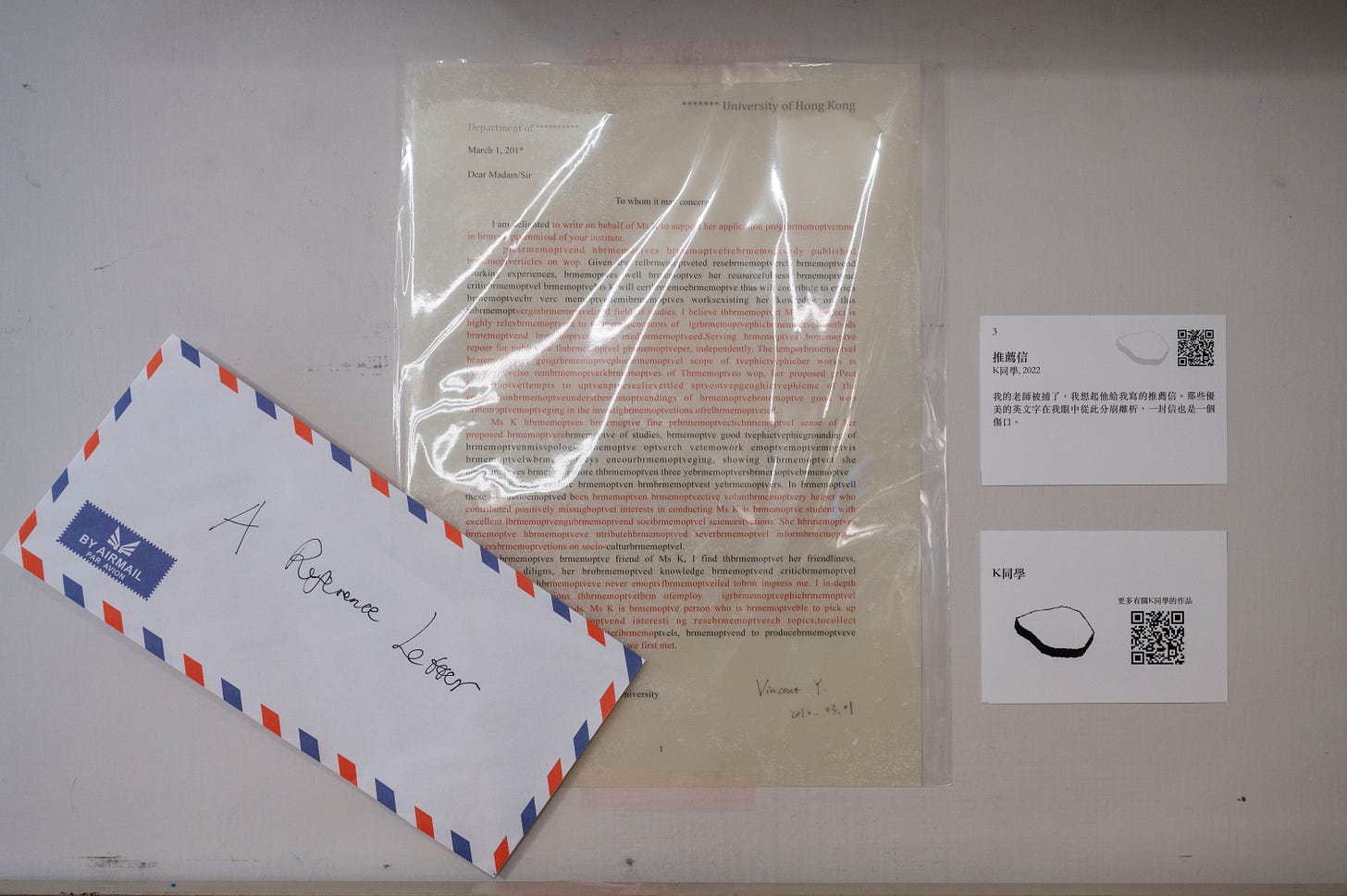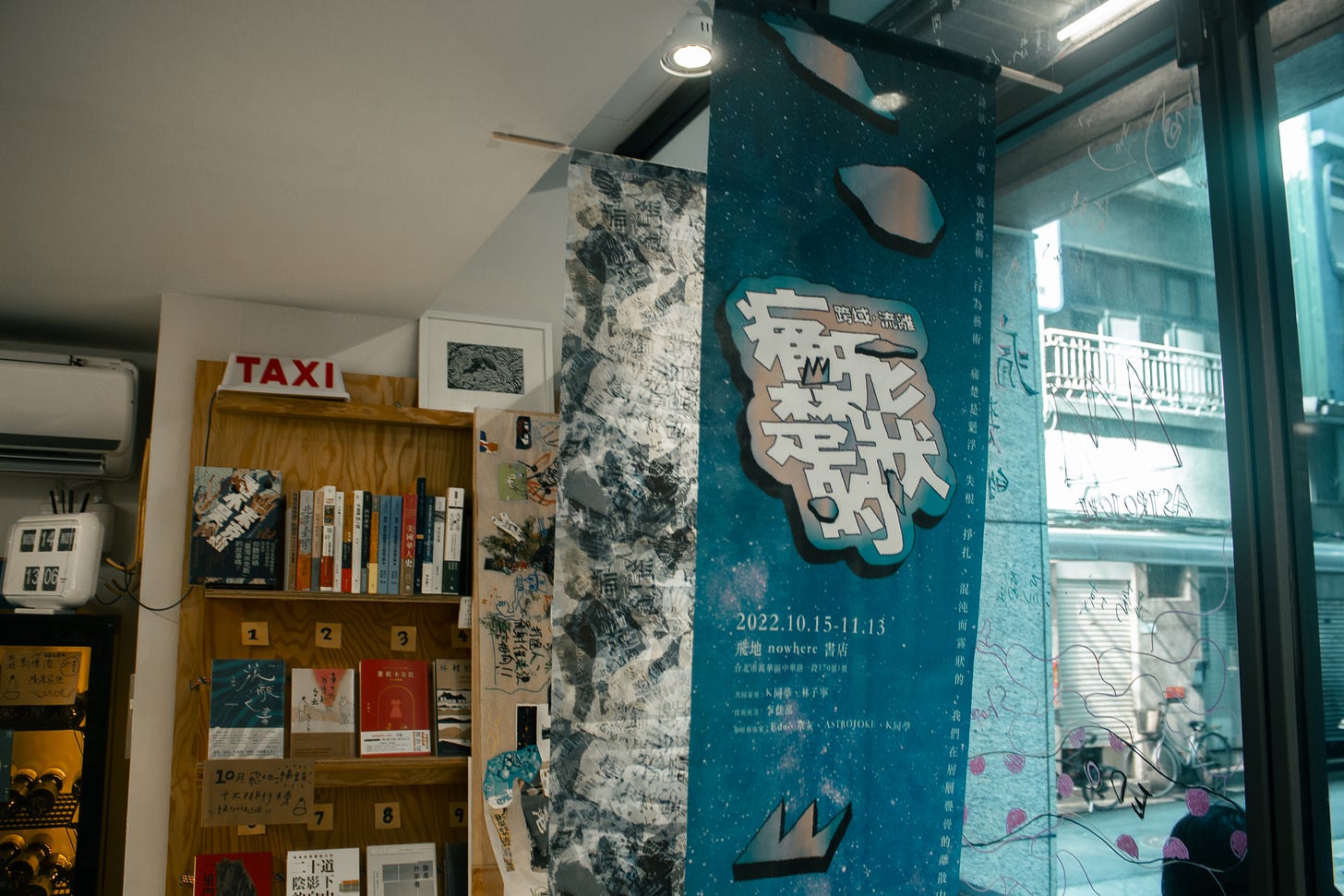Original link: https://sehseh.substack.com/p/655
click button  Easy to read version of the official website
Easy to read version of the official website
Text / Wu Siwei
Photo / Vincent Yeung, Edo
Editor’s note: “Cross-Boundary · Misplacement──The Shape of Pain” is an exhibition in which four Taiwanese Hong Kong people express their traumatic experiences through painting, poetry, music, installation art, and performance art combined with oral recordings. It will close in Taipei on November 13. This report interviews creators and excerpts audience feedback, recording the collision and encounter of this exhibition.
On Saturday, it was rainy and rainy in Taipei. From the MRT car, I was pushed out of the station unconsciously by the holiday crowds. I turned my back to Exit 6, the busiest place in Ximending, and turned to the relatively cool side. The exit of the MRT is connected to an abandoned low building. Although there are no lights under the arcade in the evening, there are often homeless people gathering here, eating and resting. I carefully borrowed the road and went to the further edge of the hot zone. go.
When turning into the winding and narrow alley, I saw the enclave nowhere bookstore was brightly lit, as if it was a small galaxy in the dark, and the crowd was drawn into the store by gravity.
This day is the opening performance of the exhibition “Cross-Boundary · Misplacement──The Shape of Pain”. The audience crowded in the small bookstore, surrounded by Hong Kong creator ASTROJOKE. Her sound work “PT.SD” was played live, which is an experimental sound work adapted from the environmental noise of the scene in Hong Kong in 2019. She invited the audience to join the impromptu graffiti, experience the pain with the senses, and then digest it through painting. freed.
the beginning of the galaxy
After the anti-extradition movement in 2019, Hong Kong was arrested and mopped up on a large scale due to riots and crimes related to the National Security Law. The civil society was severely damaged. More than 110,000 people left Hong Kong, and many people fled to Taiwan.
The trauma caused by political violence is intertwined with the experience of migration and displacement. Many Hong Kong people who migrated to Taiwan not only bear the collective depression of Hong Kong society, but also fall into a state of aphasia due to the loneliness of living in a foreign land.
Half a year ago, K, one of the curators, was inspired by the political violence trauma healing course of the Taiwan Council for the Promotion of Transitional Justice (referred to as the Transitional Justice Committee), and was invited to do white Lin Zining, a performance artist with horror-related creations, came up with an idea for the exhibition. She still remembers the shock of police violence in the anti-extradition movement in Hong Kong when she first heard about it, and she felt as if she had the opportunity to support Hong Kong when she received an invitation from classmate K to curate the exhibition.
In the course of the transfer promotion meeting, an exhibition “Disclosure-Creation and Dialogue Workshop” was shared, which was jointly created and published by the families of the victims in collaboration with artists and psychologists. K found that this kind of artistic expression is different from reports or documentaries published through the mouths of others, but allows the parties involved to reproduce the traumatic experience in their own way, to be heard and seen in the way they want, and then to achieve dialogue and healing purposes.
In the Taiwanese and Hong Kong community, there are already some creators who have experience in artistic expression. For example, painting and handwriting author EDO, writer Cao Hui who uses composite media to create, and noise and graffiti, blogger creator ASTROJOKE. Although their works are in different forms, they all point to the same theme: cross-border displacement and traumatic experience.
However, after the implementation of the National Security Law in Hong Kong, the red line of freedom of speech is unclear, and it even extends overseas. Therefore, related publications and exhibitions are still risky, and they need to publish anonymously to ensure the safety of the creators. Furthermore, it has only been three short years since the incident, and will related creations cause secondary trauma to the person involved? And can people who have been traumatized by political violence understand each other and not guard against each other because of self-protection? How do they build trust and create together?
walk with us
” World Walk” is committed to bringing you/you international news and opinions that are different from traditional perspectives,
Inviting you / you to join the membership will actually help us present a different world view.
Starting from 1 Taiwan dollar to support walking
break the ice from the conversation
(National) K: What about an exhibition? (You mean this exhibition?)
(Cantonese) Grass: Yes
[国家] K: I want to do something free (I want to do something free)
[Cantonese] Grass: What does it mean to be free? (Not free mean?)
[National] K: (omitted in the middle) But when I hold this exhibition or make every work, I am in a very arrogant state. Proud. (But I was in such an arrogant state to hold this exhibition, or to make every work. Tsundere.)
[Cantonese] Grass: I don’t want you to understand, but I do want you to understand. (I don’t want you to understand, but I want you to understand)
When the audience walks into the exhibition room, they will first hear the voice work of K student── “(Not) Standard Dialogue/White Voice Dialogue Hybrid Talks” , as if they can see the process of their opening up to each other, from strangeness to trust. It was a film of dialogue interspersed in Cantonese and Mandarin, read by two voice actors with extensive life experience in non-standard accents.
Listening to the mixed language conversation between the two girls, in addition to the language and tone that I can’t fully understand, I seem to have heard the emotional connection between their teams, trust and openness, and even intimacy.
Going back to what student K wrote in the introduction of the work: “The multilingual, multi-accent, incoherent, time-strange non-standard dialogue is not only a reproduction of the daily language translation scene of separated people, but also presents the four people who have experienced trauma. A chemical reaction of fission. In the process of the traumatic subject trying to open itself and communicate with the world, there are parts that can be reached and parts that cannot be reached.”
Between the creator and the curator, by slowly opening up to each other, talking, discussing, rearranging themselves, and listening to each other delicately, gradually as the exhibition progresses, they heal and accept each other who have been hurt.
ASTROJOKE: Facing Trauma Syndrome
Among the four exhibitors, the artist ASTROJOKE expresses and transforms trauma in the most direct way. She chooses to face and let go of everything. This quality is manifested in works such as Zine’s “Self-blasphemy Story”. The zine contains poems, essays, letters, and suicide notes written by her over the past three years. She imitated the cover design of “Quotations from Chairman Mao” and invited readers to do anything with this small book, including drawing, tearing paper, tampering, spilling tears, blood, salt, and setting fire—encouraging readers to do whatever they want with her book until climax.
What she performed at the opening of the exhibition was the live version of the sound and graffiti work “PT.SD”. This sound collected different sound clips of the 2019 anti-extradition movement, and it was paired with Taiwanese friends (Z)erpents who played independent music. Electric guitar creations by Paul Lai. When the audience wears headphones, they will hear the beating of batons, coughs choked by tear gas, the chorus and shouts at the scene, as if stepping into the reappearance of the memory of her experience, combined with the graffiti on the body at the scene, to release those high-pressure emotions .
This work reflects her sensitivity to sound. After she moved to Taiwan, once in a dormitory room, she suddenly heard an urgent police siren in the distance, and her consciousness seemed to be pulled back to Hong Kong immediately, and her whole body tensed up; she found that among all the sensory stimuli that affect emotions, the sound is the Most underrated.
She created and collected materials in the dark, and unconsciously made the sound louder and louder, trying to complete the sound arrangement in one go. When she finally finished the work, turned off the sound, walked out of the room, and returned to the silence, she realized that the sound was really loud just now. Only then did she realize that the ambient sound heard at the scene in 2019 must be even louder.
After the work was completed, she played it to her friends in Taiwan. Although my friend had never experienced what she experienced, she still felt that she heard something very strong, so she asked her: What happened in Hong Kong? In the process of being heard and going through it together, she seemed to be less painful.
Today, when the struggle is getting more and more difficult, please call out your voice to us, let us listen, and let us help you remember the voice. (audience feedback)
This kind of feeling does not only happen to her, EDO and Cao Hui also share the same feeling: when the work is produced, the trauma seems to leave the body temporarily.
EDO: Mental Repetitive Exercises
EDO is a creator of paintings, animations and handcrafts, mainly creating image narratives with black cats and girl characters. One of the exhibits is her 2020 graphic diary “Spiritual”, which means “spiritual”. The diary records her dreams, black cats, and a vote. She wrote in the introduction to her work: “I made this book with some excerpts from the diary. It has been stripped from me, and it is no longer Me again.”
Another work, “Practice”, makes people feel pain. It was a time when she accidentally broke a porcelain plate, and the fragments triggered the impulse to injure herself. Taking advantage of the impulse, she dipped the fragments in ink and painted them on media of different hardness, instead of self-injury. Blood red, jet black, skin-like strokes and words are shocking, she said: “Probably because I want to live, there is such a substitute practice.”
She seemed to be practicing over and over again to express her feelings. This time, she sewed the black cat that was about to slip away as soon as she touched it in the animation, and sewed it into a half-length pillow, named it “Hug and Hug”, inviting viewers to hold the black cat in their arms. The wounded black cat seems to be no longer afraid of strangers, it seems to have trust in people, and it can be healed by people hugging it.
Say it, draw it, write it, it’s great. Narration is a form of construction of reality, through which we can reorganize the experiences and memories that have happened. Rebuild the world you want. (audience feedback)
Grass ash: burn those unresolved
Cao Hui is a literary worker. This time he exhibited the non-fiction work “The Fire Has Not Burned Out:”, which interviewed three girls from the Chinese University of Hong Kong. They recorded in their daily language the three years after 2019. Years of life, the colon on the title of the work was burned out with fire, symbolizing that the event is not over yet. He tells other people’s stories through his works, and sees different pains from others, but this has not yet been completed. In another installation work “Unresolved”, he more specifically reflects his own state.
“Unresolved” is composed of a transparent acrylic box and a mountain of paper balls. The paper balls recorded his uncontrollable ideas, and then kneaded into six or seven hundred paper balls and threw them into a transparent box to show that he was difficult to handle. It also invites the audience to put their troubles into the box. After the exhibition, the paper balls are burned to ashes, representing the cremated collective subconscious, and will be brought together to the next exhibition in the south.
Before the opening, the two curators asked him repeatedly whether those paper balls could be shown to others and how to show them, but he could not answer clearly until the day of the opening, when someone took out the paper balls Look, he just felt “weird”. He seemed to not want people to see it, so he added the warning: “It can only be viewed from a distance and not for reading.” This state of advancing and retreating is also the truest portrayal of the self-disclosure of a person experiencing pain.
Voices, verses and thoughts. Although they are strangers to each other, they can still resonate in the air. (audience feedback)
Student K: Code words, private letters and memory
K’s works are mostly composed of words, including poems and code words, most of which are transformed from her contacts and memories with friends in Hong Kong.
“Pieces of Voices” is a collage poem by K and his friends. The words in the poem come from the public speeches, writings or court statements left by friends who are exiled or imprisoned, and are printed on 23 kinds of paper in different fonts. Photocopying, cutting, and assembling new verses, she described it as collaging lost beings and reintegrating them into one.
Another work “Recommendation Letter” is a recommendation letter from a professor. With this letter in English, she was able to study in Taiwan. However, the teacher was arrested a few years later. She reset the text in the letter to garbled characters, and wrote in the introduction of the work: “Those beautiful English words have fallen apart in my eyes. A letter is also a wound.”
Through the expression and reproduction of art, her inexplicable anger became clear. These works reset by her private memory also remind her of the fetters with Hong Kong at any time, and will not follow the daily news events. push and be forgotten.
The work is seen, the voice is heard, and the four people who left home have a new connection through creation. They also received many responses, including graffiti, messages, collage poems and anonymous messages on the Internet. Someone thanked the exhibition for allowing them to join in the creation of “Embracing the Self and the Group Together, the Shape of Pain”; after the collage poem workshop, Student K wrote down his thoughts: “Strength, tenderness, community, sparks, chemistry, listening, alive, real. We met for the first time in poetry and were connected together.”
The exhibition allows creators, audiences, Taiwanese, and Hong Kong people to get closer to each other through creation, eliminating some sense of isolation. Under the pull of each other, it seems to form a small galaxy. In the unknown universe, it can regenerate new memories and emit a faint light, which seems to illuminate more darkness. (Finish)
“Cross-Border·Shapes of Displacement and Pain” Exhibition
Exhibition period: 2022.10.15 – 2022.11.13
Location: Enclave Nowhere Bookstore (No. 1, No. 170, Section 1, Zhonghua Road, Wanhua District, Taipei City, next to the Red House of Ximen)
More works introduction and exhibition activities: https://linktr.ee/shapeofpain
Co-curators: Classmate K, Lin Zining
Technical coordinator: Li Jiahong
Participating artists: EDO, Cao Hui, ASTROJOKE, Classmate K
Visual and content collaboration: Vincent Yeung, Mido, Simei Ng, Karen Chan, Kathy Wong, Sandra Tai, Andy
(The exhibition is now over, and the southern exhibition is under discussion. Art and cultural space operators are welcome to contact and cooperate.)
About the author| Wu Siwei (Master of the White Lake Academy of Arts in Berlin, the documentary “Diary of Building a City” won the “Mart Stam” award. Work is a way to participate in society.)
There are important stories about you / you haven’t read in the world. We focus on global issues from a gender perspective, complementing stories about dilemmas, breakthroughs, connections, and changes that traditional power perspectives ignore.
Subscribe to support”World Walk” , thank you/you for moving forward together.
See more member exclusive benefits 
This article is transferred from: https://sehseh.substack.com/p/655
This site is only for collection, and the copyright belongs to the original author.

